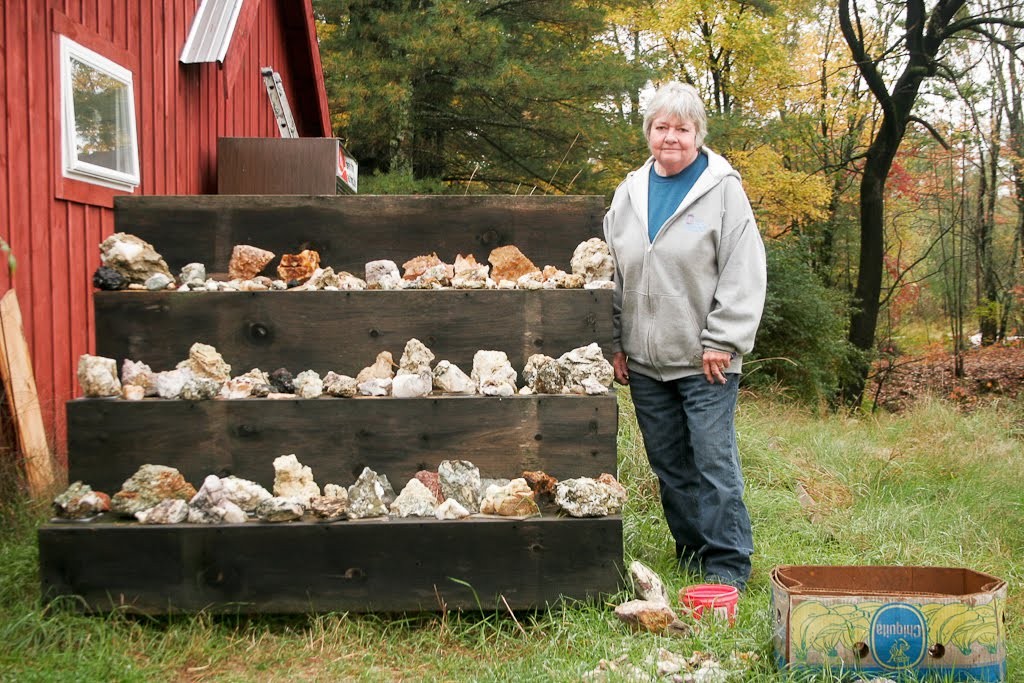Two days amidst a New England vacation, dedicated to food, foliage, and hiking, were also earmarked for mineral collecting in Maine. The first day saw torrential rain, severely limiting visibility. While the weather discouraged collecting, it didn’t prevent a six-hour drive through southwestern Maine, planning an itinerary for better conditions. This pre-planning saved valuable time the following day, which turned out to be perfect for mineral hunting.
Even in the downpour, I managed to miss the small sign along Route 26 near the high school pointing to the Poland Mining Camps. Founded by the late Irving “Dudy” Groves (1919-2005) and now managed by his welcoming widow, Mary Groves, the camp is a prime destination for serious collectors seeking the gems and minerals that Oxford and Androscoggin Counties are famous for. Although tourmaline dominates, the area’s numerous mines, prospects, and quarries offer a diverse selection of minerals to satisfy nearly any collector’s interests.
My primary goal was to visit the Tamminem and Harvard Mines, mentioned in a previous post based on Nancy Millard’s talk at the Atlantic Coast Gem and Mineral Show. These two pegmatite sites are conveniently located near each other and are among the few openly accessible locations in the region. Thanks to Mary’s call, I was assured a warm welcome to collect.
The Tamminem and Harvard Mines are regular destinations for the Camp’s field trips, but they have been mined more extensively compared to other locations owned or exclusively accessed by Poland Mining Camp, such as Mt. Apatite. Information detailing the minerals found at each site, including a map, is available through a link on the Poland Mining Camps’ website. A valuable resource for any collector is A Collector’s Guide to Maine Mineral Localities by W. B. Thompson, D.L. Joyner, R.G. Woodman, and V.T. King, accessible online through the State of Maine. This guide provides crucial information, including detailed directions to reach many of the localities.
Navigating from Poland Mining Camps, I arrived at the parking area for the Tamminem and Harvard Mines, located on Richardson Hollow Road, a short distance from its intersection with Greenwood Road in Oxford County. The Tamminem Mine is a quick walk downhill from the parking spot. Here, I found plenty of common schorl and some respectable clevelandite. Following Mary’s advice, I was thrilled to discover micro blue apatite. Experienced collectors with keen eyes might also find rare pollucite crystals within seams of petalite, which can be hard to distinguish from feldspar.
Reaching the Harvard Mine requires a half-mile hike up a mountain trail across Richardson Hollow Road from the parking lot. While historically known for fluorapatite crystals and lustrous cassiterite, I didn’t find any. However, the stunning view and abundant schorl, more impressive than at Tamminem, along with attractive almandine crystals, made collecting at the Harvard Mine a more enjoyable experience.
Heading towards North Conway, New Hampshire, for the night, I took a route near the Lord Hill Mine close to Stoneham in Oxford County. This publicly accessible mine is renowned for giant quartz crystals, large blue and colorless topaz crystals, and many rare phosphate species similar to those found at the Palermo Mine in North Groton, New Hampshire. Reaching Lord Hill involves navigating a network of dirt roads and a mile-plus hike. Unfortunately, I arrived near Stoneham too late to explore the mine before dark.
Next summer, I plan to revisit this region of Maine and hope to make the Poland Mining Camps my base for an extended stay. Regardless, a trip to Lord Hill is definitely on the itinerary. This collector’s guide to Maine mineral localities is just a starting point for exploring the state’s rich geological offerings.

